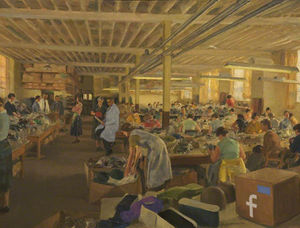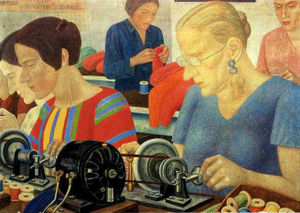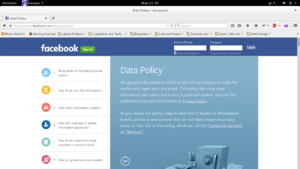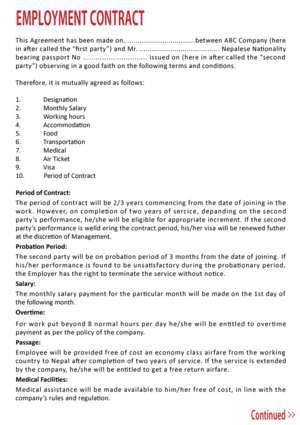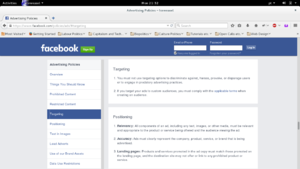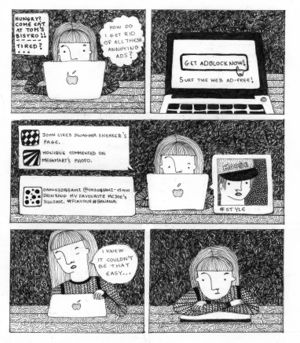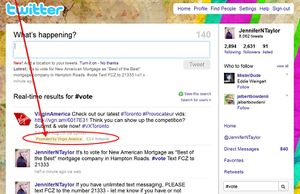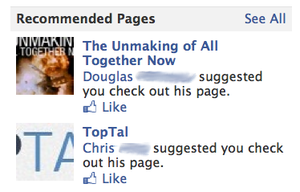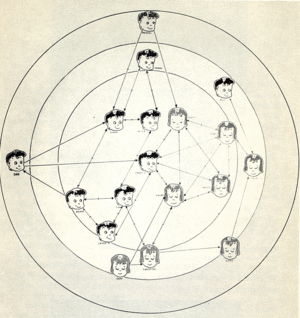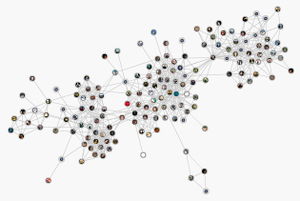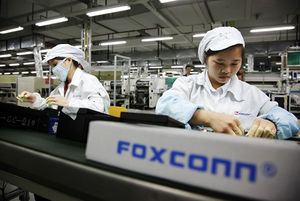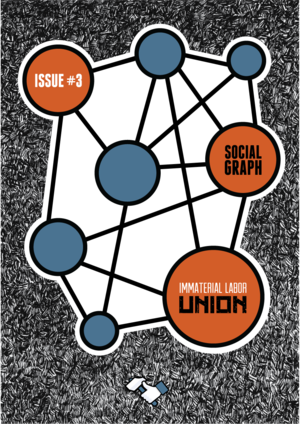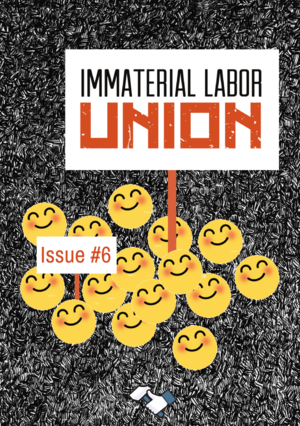Immaterial Labor Union
| Immaterial Labor Union | |
|---|---|
| Name | HDSA 2016. If you are so smart why are you so poor |
| Location | De PUNT |
| Date | 2016/07/24 |
| Time | 10:00-18:00 |
| PeopleOrganisations | Lídia Pereira |
| Type | HDSA2016 |
| Web | Yes |
| Yes | |
Talk by Lídia Pereira during HDSA2016
Back to basics
The concept of playbour is essential to understand immaterial labour within the context of corporate social networking platforms. It refers to the blurrying lines between work and leisure. An example is how activities such as liking a friend status on Facebook or uploading a picture to Twitter become monetised.
How?
In the 1970s, Dallas Smythe wrote that our services, as audiences, are sold my mass media of communications to advertisement agencies. These advertisers pay for specific audiences who, at a predictable time and in predictable numbers, will be paying attention to either a TV channel, a newspaper, a radio station etc. Christian Fuchs and Sebastian Sevignani pick up on Dallas Smythe's definition to argue that in corporate social networking platforms such as Facebook, Twitter, Instagram et al profits are derived from selling user data for targeted advertisement purposes.
Why is this work?
Marx's definition of work refers to the action of the human upon objects and instruments of labour for the creation of a product with use-value. Fuchs and Sevignani adapt this definition to the digital space of commercial social networks, where the objects are human experiences and online information, the instruments are the brain, the hands, the social network platform itself and speech. The products are social relationships and experiences, who satisfy the users' need for social interaction. This becomes 'problematic' once this product adquires an exchange-value. Marx, Fuchs and Sevignani see a distinction between work and labour, where the second refers to work occurring under a capitalist mode of production - that is, alienated work. These processes occur simultaneously, and at the same time as the product of our social media labour satisfies the users' needs, it satisfies also the platforms' need for profits.
Deconstruction of the corporate social networking equation with labour -> Division into smaller particles and comparison of those particles with traditional workspace artifacts.
Terms of Service
Terms of service regulate the data exchange between users and the platform. These documents can be conceived as the data labour iteration of an employment contract.
For example, as Facebook employees we are to keep our contact information accurate and up to date, impeccably curated so we don’t provide any false personal information - the more accountable we are, the more profits we derive for our employee. We are also to agree with the use of our name, profile picture or other personal information in connection with commercial or sponsored content.
There is no real option to discuss these terms, either we accept or we are out. While this is certainly a viable option, in most cases the ‘network effect’ ensures that it is not the most feasible option for the vast majority. The ‘network effect’ is present whenever a service is the more valuable the more users it has.
Advertisement
Here we go back to our previous exposure of Smythe's audiences as commodities. Facebook, Instagram, Twitter and such derive their profits from selling your interests in movies, music, books, companies and people to advertisement agencies which then are able to better ‘serve’ you. Having AdBlock installed might indeed protect users against plenty of unwanted advertisement, but there are certainly plenty of other ways to advertise: recommended pages, corporate pages that function almost as normal user pages, pictures of friends using certain products, contests where you can only vote if you first like a company's page,campaigns sponsored by brands, etc etc.
Social Graph
The Social Graph was initially introduced within the context of Facebook in 2007. Harry Halpin and Yuk Hui trace the social graph's origins back to the sociogram, an instrument developed by the psychologist Jacob Levy Moreno in the late 1930's. Moreno's intervention was sollicited at the New York State Training School for Girls Hudson where the runaway rate was very high. Moreno started his intervention by conducting a survey which consisted of questions regarding the girls’ preferences towards each other - who would they rather work with, or live in the same dormitory with, for example. Moreno then devised several diagrams of the girls’ social network in terms of nodes and links, where every node represents a person and every link represents a relationship. On the basis of such observations, Moreno diagnosed the problem as one embedded within the existing dormitory arrangements - the position held by a girl within the community might increase her runaway risk.Juxtaposing these socio-technical charts upon current dormitory arrangements, a better functioning, more productive network emerged.
For the sake of our comparison, we will attribute the Social Graph the role of the manager, whose function is to organize its employees in the most efficient arrangement possible.
The Social Graph has now expanded to become an attempt at the graphical representation of relationships between everybody and everything on the internet. This representation is done in terms of nodes (users, pages, etc) and links (relationships) between them. It has became the largest social network dataset in the world.
We can look at the Social Graph from the point of view of social engineering. The mainstream definition of social engineering characterizes it as a discipline in social science regarding the efforts undertaken by fovernments, media or other private groups to influence public opinion and attitudes. To put it simply, it is an instrument at the service of economical reproduction. This seems to be the case here: your position in the graph largely determines which content you see, so whichever friends you interact with the most will be the ones whose content will be more likely to show on your feed. This is, of course, a great way to combat unprofitable idiosyncrasy and unpredictability.
User Profile
A user profile might be the equivalent to a curriculum vitae. It is a selling point wherein we market ourselves to possible investors - of either time, money, etc. Just like with CV's, there's a pressure for our user profiles to be carefully managed and curated so that we appear in the light we consider the most favourable.
How Immaterial is Immaterial Labour?
Very dangerous to obscure the material basis of 'immaterial' labour. Very blatant examples: Open air mines in Congo, Foxconn assembly lines. Also, 'immaterial' conceals users' very material needs.
Unite?
If we are working willingly, though not always knowingly, why are we not organising? Plenty of challenges:
- We don’t feel corporate social networking’s painful strain the way factory, office, public service and all other sorts of waged and non-waged workers do. However, more dangerous effects we might not feel due to relatively privileged position: from real names policy, which has more than once discriminated against sexual and ethnic minorities to authoritative states making use of facial recognition software to identify protesters in photos users post on these networks.
- Who to address? What to demand?
- Historic challenge: How to demand better working conditions whilst advocating for alternatives? How to avoid reproducing a deeply flawed system by following the same path many unions have followed (institutionalization and bureacratic management)?
Unite!
More hopeful perspective. Engels and Marx (who were both harsh critics of institutionalized unions "Too exclusively bent upon the local and immediate struggles with capital, the Trades' Unions have not yet fully understood their power of acting against the system of wages slavery itself."Marx, 1866) defense of the unions as vital instruments in the transition to real existing communism ("they must now learn to act deliberately as organizing centers of the working class in the broad interest of its complete emancipation. They must aid every social and political movement tending in that direction. Considering themselves and acting as the champions and representatives of the whole working class, they cannot fail to enlist the non-society men into their ranks."Marx, 1866). Unionism as revolutionary praxis which falls under what Vincent Mosco and Katherine McKercher call Social Movement Unionism, urgent under knowledge and information economy a call for traditional labour unions to drop bureaucratic management and join forces with other forms of labour organisation, grassroots activist organisations and other social movements in the fight against capital.
Immaterial Labour Union
Ongoing project which seeks to politically organise corporate social networking labour. Strategy used to tackle the different challenges consists in the ellaboration of smaller projects in an attempt to mobilise and organise demands, campaigns and actions. First project was the creation of a zine which offers a low-barrier entry level for contributors to express their views on the themes already mentioned within this presentation, but also a low-barrier entry level for those wishing to become acquainted with these debates. It thus hopes to launch the seeds for an emancipatory workers' movement.
Second project, still embryo phase: the care package. The care package first appearead within the context of post-World War II. CARE , an american initiative,started a program to send food relief to Europe. Americans could buy a CARE package for 10 dollars and send it to friends or relatives in need.
Later, they started including food for different cultural diets, as well as medicine, tools, blankets, school supplies, etc.
This project is so named to highlight the often obfuscated community aspect of the digital multitude. It intends to reintroduce affect at the service of community empowerment when this affect is now being used to exploit it. There are plenty of very good toolkits for self-defense against surveillance already available on the web. However, the care package seeks to not only provide to means to self-defend within the current system, but also the means to start dismantling it.
